 It’s almost year-end and it’s time to set your company’s sights on the new year. Large companies have been working on next year’s budget since August but mid-size and smaller companies are usually focused on finishing the current year with a bang. Companies of all sizes need to make strategic plans for the new year. Now is the time to plan a leadership retreat or half-day planning session to envision a fantastic new year for your organization. Brio Leadership has helped a multitude of companies and large departments make plans for their new year. We want to share five secrets with you about the process.
1 Comment
Gender diversity in the workplace is not just a feel-good issue for women; it’s a financial imperative for companies. Studies show that gender diversity, especially in the top ranks, positively affects financial outcomes of an organization. McKinsey & Company, the global consultancy, and Lean In, a non-profit dedicated to women’s parity in the workplace, recently published their latest research report on gender diversity called Women in the Workplace 2018. The results of this year’s research show women are vastly underrepresented at every level of the organization and that their percentages have not increased over the past four years. Indeed, progress towards gender diversity has stalled.
Furthermore, this study states that women are doing their part to “lean in”: they are getting college degrees at higher rates than men, they ask for raises and promotions, and they stay in the workforce at the same rate as men.  The Queen of Hearts in Louis Carroll’s Alice’s Adventures in Wonderland commanded “Off with her head!” at the slightest offense. Although this fictional story was written over 100 years ago, there are lessons from this story that can be applied to 21 st century work culture. Many inexperienced or uninformed leaders in today’s dynamic workplace may inadvertently “kill” the whole team when only one person makes a mistake. I was reminded of this ill-advised practice by a colleague of mine, a millennial who is still early in his career. He told me that his boss sent out an email to the whole team with a correction, a directive that asked for different behavior. The boss said that he’d heard complaints and wanted them all to pay better attention to their customers. Trouble is, this colleague of mine was already doing just that. The boss acted the best he knew how – he sent out an email to all eleven of his team members. But the result of his action was an unintended consequence of his inability to address the one or two team members who were not paying proper attention to customers.  In our increasingly secular world, religious participation is on the decline overall. However, at the same time in the United States, there are many religious institutions that are in fact thriving and growing. What do these organizations do to create a cohesive community of thousands and excite their congregations in these times of religious decay? I was pondering this at a recent conference on organizational culture, where I began listing some traditions churches and other religious communities use to draw people together and create positive organizational cultures. I thought of practices like community worship, commitment to high ideals, prayer, small group meetings, potluck dinners, receiving an offering and community service or mission work. While not all religious practices are best applied to a diverse and inclusive workplace, there are many ideas that a company can re-purpose from religious organizations to create a better team culture. Let’s examine them separately: 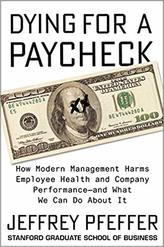 We complete our series of the shocking revelations found in Dying for a Paycheck: How Modern Management Harms Employee Health and Company Performance – and What We Can Do About It, by author Jeffrey Pfeffer. Professor Pfeffer cites numerous research studies that show that toxic management practices are very harmful to the human body, perhaps even more detrimental than exposure to second-hand smoke. In this part of our book review, we focus on the need for social support in the workplace, and the detrimental effects on both workers and organizations when social support is not present. As before, the picture is not a pretty one. 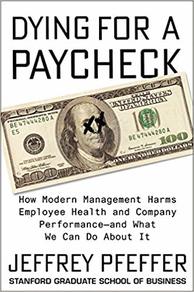 We continue our series of the shocking revelations found in Dying for a Paycheck: How Modern Management Harms Employee Health and Company Performance – and What We Can Do About It, by Jeffrey Pfeffer. In this book, Professor Pfeffer establishes that there is a connection between toxic workplace practices, employee health, and organizational performance. Part one of this blog series on this book focuses primarily on Pfeffer’s most damning claim, which is that toxic workplace practices are more harmful to an employee’s health than exposure to second-hand smoke. Pfeffer effectively makes the claim that modern workplace stress can literally kill you. In Part Two of our book review, we’ll discuss two of the ten dangerous workplace practices identified in the book. Those two practices are #6: Work/Family conflicts and #7: Low job control. Again, the picture is not a pretty one. 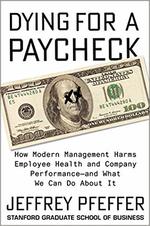 In his shocking book, Dying for a Paycheck: How Modern Management Harms Employee Health and Company Performance – and What We Can Do About It, author Jeffrey Pfeffer recounts the research he and colleagues have done to examine the management practices that establish the expectation that employees must work themselves to death – literally – to advance their careers. Pfeffer, Professor of Organizational Behavior at Stanford Graduate School of Business, firmly establishes the connection between dysfunctional workplace practices and both employee health and organizational performance. It isn’t a pretty picture. Recently I was made to wait two weeks to get an important prescription filled. Two weeks! And I live in a first-world country and have decent health insurance. After a week of receiving pre-recorded apology updates from the pharmacy, I called both the doctor’s office and the pharmacy, and discovered the doctor’s office hadn’t received any of the faxed pre-authorization requests the pharmacy was sending every morning. Knowing that, I asked the pharmacist to directly call the doctor’s office and ensure they completed the authorization form for insurance. I finally got the medication and felt better within a day, but now I am looking for another doctor because of this debacle! Poor customer service is always a reflection of a negative culture. The root cause of my unfortunate experience was the poor organizational culture at my doctor’s office, reflected in their unresponsive administrative personnel and poor customer service processes. Here is the formula: To say it succinctly, employees treat customers in a manner consistent with how they are treated. If management yells at employees, they are in turn likely to be surly with customers. If management does not give the employees the tools, empowerment or training to serve the customer well, the customer will suffer. And when the customer suffers, so does loyalty and satisfaction and that negatively impacts customer retention, which negatively affects profitability. It’s a vicious cycle.
 All professional women, and the men they work with, need to read a very timely and informative book called How Women Rise by Sally Helgesen and Marshall Goldsmith[1]. I was so excited to discover this book that I read it in one sitting. It is an important contribution to the understanding of how women can adapt their behaviors to get ahead in a male dominated workplace. Authors Helgesen and Goldsmith are a star-studded partnership. Since publishing her best-seller The Female Advantage in 1990, Helgesen has been a sought-after leadership coach, author and speaker. Goldsmith is known as “the world’s preeminent executive coach” and is the author of several New York Times bestsellers, starting with What Got You Here Won’t Get You There. These two heavy-weight authorities have great advice for women that’s based on their decades-long experience observing and coaching both women and men. Like it or not, the #MeToo movement has changed everything. Company executives can no longer leave their culture to chance or they may find their company featured in the news in the wrong way. Creating a positive, responsible culture that holds all team members accountable to the company’s values and standards of conduct is the best prevention of the abuses of power revealed by the #MeToo movement. In today’s atmosphere, all leaders must evaluate their organization’s culture and identify areas of vulnerability and potential problems. And evaluating your culture will also identify the strengths of your culture, from which you can build an even better one. The good news is that you can objectively measure your company’s culture. The bad news is that not all so-called culture assessments truly measure it. Some of these assessments that purport to evaluate organizational culture are instead measuring the climate of the organization. To understand this, let’s start with definitions of organizational culture and organizational climate to help make this distinction. Organizational Culture is a combination of values, beliefs, and behavioral norms (meaning the way a team member must behave to fit in). Values and beliefs are hard to measure. You may think that values are easy to perceive – after all, most companies have their values posted on the wall! To the contrary, what we are referencing are not the values that are declared but the actual values that are exemplified by the actions of the leaders and team members. Although most organizations espouse positive values, the way people actually behave can exemplify a different set of values. For example, a company may declare integrity to be a core value, but the best sales people pad their expense reports with a few personal purchases while management turns a blind eye. Beliefs, though truly invisible, are the foundation of any culture. An example of an organizational belief is “money is scarce, so we can’t take any risks with our money”. Certainly, actions can refer to beliefs, but it is very difficult to tease out the underlying beliefs of a company.
|
From the desk of
|
Our services |
Our Company |
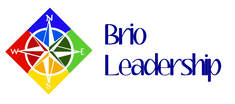


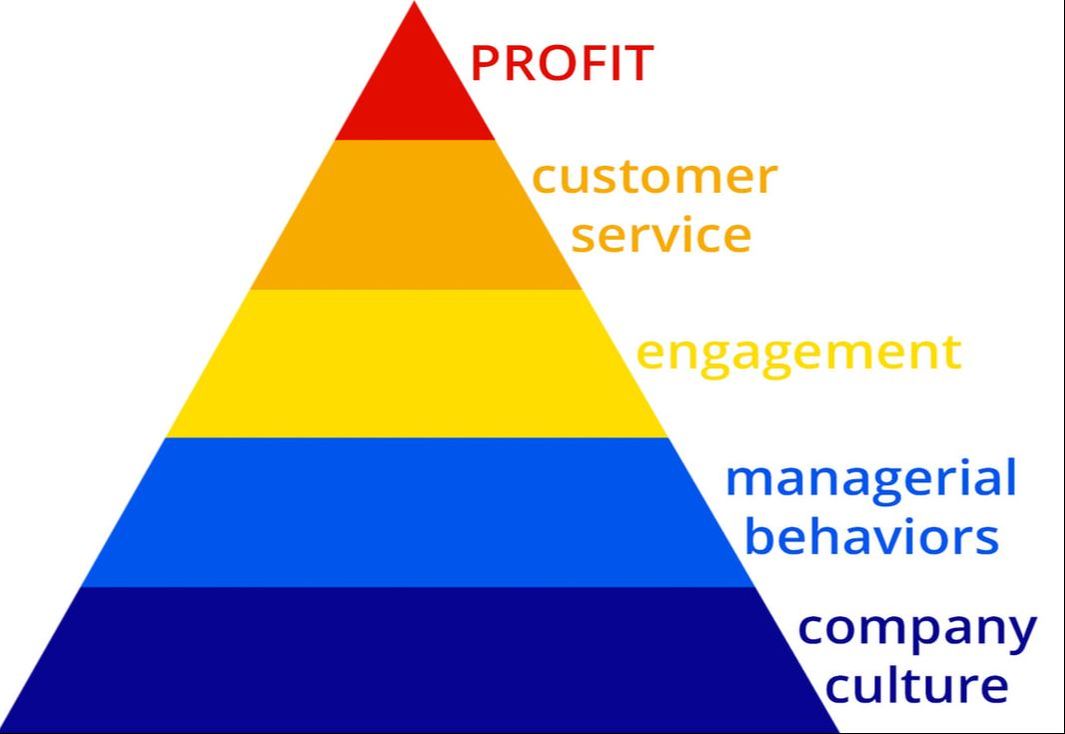

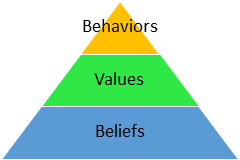
 RSS Feed
RSS Feed

